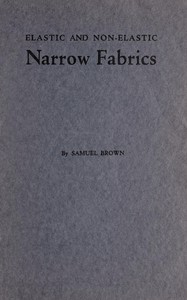Elastic and non-elastic narrow fabrics : and a chapter on narrow fabrics made…
"Elastic and Non-Elastic Narrow Fabrics" by Samuel Brown is a scientific publication written in the early 20th century. The book delves into the intricacies of weaving techniques and machinery used for elastic and non-elastic fabrics, particularly focusing on narrow fabrics such as garters and suspenders. It provides a detailed exploration of the growth and evolution of the webbing business, the technological advancements in loom settings, and the operational procedures involved in the
manufacturing processes. The opening of the text discusses the historical context of the webbing industry, detailing the introduction of elastic web weaving in the United States around the 1860s. It outlines the challenges faced in transitioning from wide looms to narrower versions while maintaining fabric quality. Moreover, the text highlights various techniques involving loom vibration management, the capacity of machines, and the distinctive features of the weaving process that have evolved over time. Overall, this portion establishes a foundation for understanding how elastic fabrics have become integral to numerous everyday products, emphasizing the technical and commercial aspects of their production. (This is an automatically generated summary.)
Read or download for free
| How to read | Url | Size | |||
|---|---|---|---|---|---|
| Read now! | https://www.gutenberg.org/ebooks/68583.html.images | 221 kB | |||
| EPUB3 (E-readers incl. Send-to-Kindle) | https://www.gutenberg.org/ebooks/68583.epub3.images | 3.2 MB | |||
| EPUB (older E-readers) | https://www.gutenberg.org/ebooks/68583.epub.images | 3.2 MB | |||
| EPUB (no images, older E-readers) | https://www.gutenberg.org/ebooks/68583.epub.noimages | 203 kB | |||
| Kindle | https://www.gutenberg.org/ebooks/68583.kf8.images | 3.7 MB | |||
| older Kindles | https://www.gutenberg.org/ebooks/68583.kindle.images | 3.7 MB | |||
| Plain Text UTF-8 | https://www.gutenberg.org/ebooks/68583.txt.utf-8 | 184 kB | |||
| Download HTML (zip) | https://www.gutenberg.org/cache/epub/68583/pg68583-h.zip | 3.3 MB | |||
| There may be more files related to this item. | |||||
Similar Books
About this eBook
| Author | Brown, Samuel |
|---|---|
| Contributor | Davis, William, M.A. |
| LoC No. | 24006173 |
| Title | Elastic and non-elastic narrow fabrics : and a chapter on narrow fabrics made on knitting machines |
| Original Publication | United States: Bragdon, Lord & Nagle Co.,1923. |
| Credits | Charlene Taylor and the Online Distributed Proofreading Team at www.pgdp.net (This file was produced from images generously made available by The Internet Archive/American Libraries.) |
| Reading Level | Reading ease score: 60.9 (8th & 9th grade). Neither easy nor difficult to read. |
| Language | English |
| LoC Class | TS: Technology: Manufactures |
| Subject | Textile fabrics |
| Subject | Weaving |
| Subject | Looms |
| Subject | Elastic fabrics |
| Subject | Rubber industry and trade |
| Category | Text |
| EBook-No. | 68583 |
| Release Date | Jul 21, 2022 |
| Most Recently Updated | Oct 18, 2024 |
| Copyright Status | Public domain in the USA. |
| Downloads | 198 downloads in the last 30 days. |
| Project Gutenberg eBooks are always free! | |

